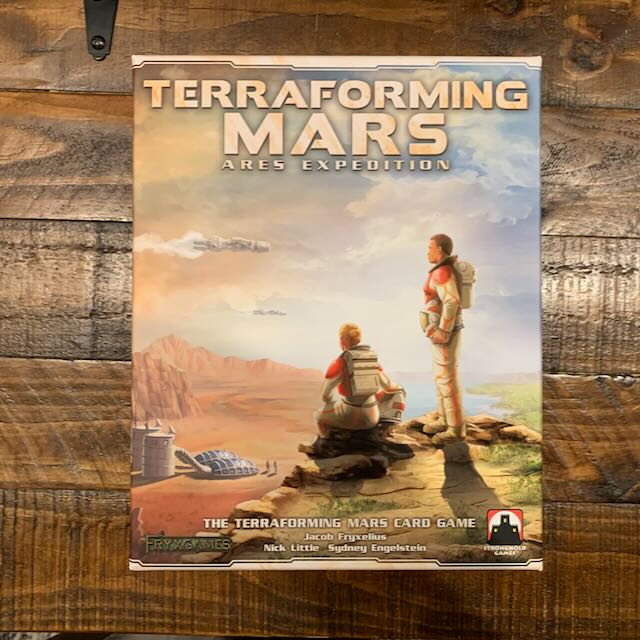
When I first played Terraforming Mars at a friend’s house, it invaded my brain like no other game before. For the next few weeks, I was thinking about what I could have done differently. What strategies could I employ the next time I had a chance to sit down with the game? If I got a certain corporation, which cards and production should I start focusing on? Alas, my game group meets once a month so I don’t get to play as often as I would like. So, when I heard Terraforming Mars Ares Expedition is a shorter, card based version of the game that has a good solo mode, I knew I had to try it out.
Terraforming Mars Ares Expedition Overview
Terraforming Mars Ares Expedition is a card game for 1-4 players designed by Sydney Engelstein, Jacob Fryxelius and Nick Little and published by Stronghold Games. I use the term card game lightly. Upon opening the box, I was greeted with the currency, player, and tracking cubes, and a hexagonal-spaced board of Mars similar to the original TM. The collector’s edition of the game solved a major gripe I had with the original TM–the player resource tracking boards! They are double-layered and have recesses to keep all your cubes in place! Sweet!
The cards are much better also. The card stock is thicker and artwork was redone. Both again are great updates. In looking over the board, gone is the tile placement aspect of the original. Instead, the 9 water tiles are set on the board face down from the beginning and are used to help track the terraforming parameters and supply rewards. The board itself is a bit small and I do (kind of) question if it was needed in the first place. I feel the global parameters could have been tracked with a smaller double-layer board like the player boards.
Terraforming Mars Ares Expedition Setup
Setup of Ares Expedition is pretty quick. Each player gets 1 corporation card, 8 project cards, and sets their resources according to their corporation. Players also get 5 phase cards. When playing solo, you deal the AI player 5 of these phase cards shuffled and placed face down. The board setup is similar to the original. Shuffle up and place the 9 ocean tiles face down on the board. Temperature and oxygen levels are set to their lowest setting. Then the terraforming rating for the solo player is set to 5 and the AI player is set to 1. This is a 5 min set up at most.
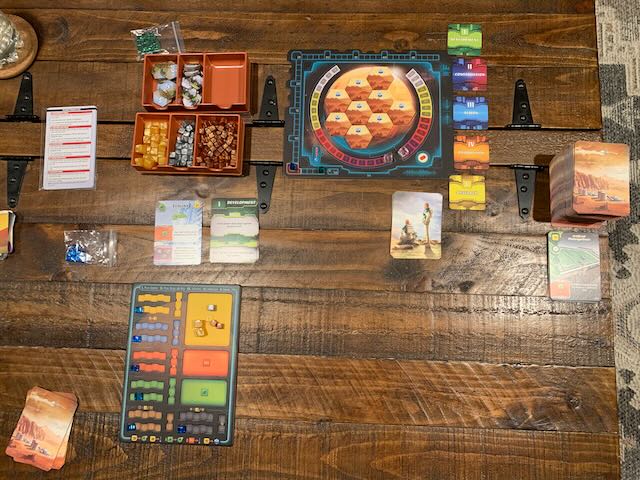
A Phased Approach
Rather that the game playing out over several generations like in TM, Ares Expedition is played in phases–5 phases to be exact.
- Development – Play a green project card.
- Construction – Play a red or blue project card.
- Action – Take actions on your blue card or the standard actions. (create an ocean, raise temperature, raise oxygen)
- Production – Gain resources according to your terraforming rating and player board.
- Research – Draw new cards.
These phases are played at the beginning of a round and each player can only choose 1 phase card to play per round. If 2 players choose the same phase, you still only perform the phase once. This makes for a bit of gamesmanship in phase selection, trying to feel out what phases your opponent needs and deny them that phase or take advantage of phases they play. The same phase also cannot be played 2 consecutive times by a player. This adds a nice layer of strategy to the phase selection process.
Timing is Everything
In the solo version, the AI player does get the 5 phase cards. These cards are shuffled and placed face down. During a turn, you play a phase card then reveal the AI phase card and play the actions. All phase rules still apply here, so if you both play a production card, you only produce once. In addition to being able to take the actions on the phases for their turn, they also act like a game timer. After each of the 5 phases are played by the AI, you move the AI cube 1 space on the terraforming track. Once the AI cube reaches space 5 on the track, it is game over after that round. If Mars is not completely terraformed by then, you lose the game. If you do manage to terraform the red planet, add up your victory points to see how well you did.
Ares Expedition Solo Play Impressions
Start Your Terraforming Engines!
My favorite part of the original TM was the economic engine you built off your cards that were played. Building those combos and watching your engine grow was so satisfying. Ares Expedition makes that engine building the core mechanic of the game and it rocks. All the tags, events, production growth, animals, and algae are there, and with the way the cards are designed, it makes them so easy to layout and read. Being able to lay your tableau out left to right instead of top to bottom is a great space saver.
One item I really liked about Ares Expedition is how steel and titanium are treated now. Instead of receiving cubes that you then use for a discount, it is now a cube on a production track that you move. This gives a permanent discount to cards played with the appropriate tags. Genius!
Over the course of my solo plays, the engine building was so smooth and ramped up wonderfully. When the AI was hitting the third marker, Mars was just barely being terraformed but the engine was revving up. Over the next 2 markers, I had made so much progress that Mars was nearly or completely terraformed by the end.
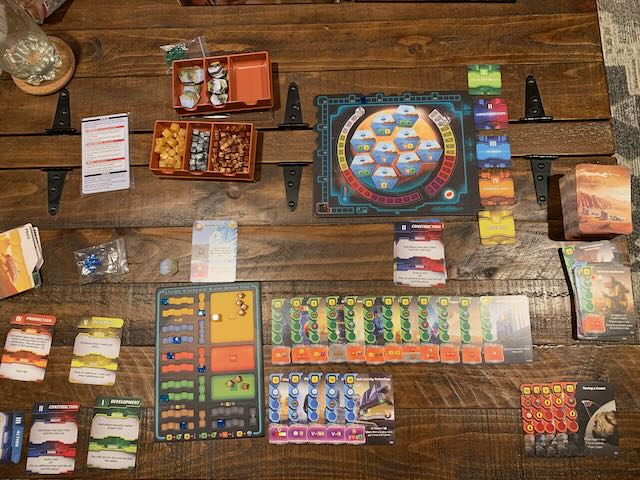
Gravity is Not Lighter in Terraforming Mars Ares Expedition
Terraforming Mars Ares Expedition is not really a lighter game than the original TM. For those that are new to TM in general, there is quite a bit going on as your tableau grows and things can get overlooked. Thankfully, the cards do tell you what phases they activate on so, as long as you pay attention to the symbols on your tableau, you should be good. For those that are TM vets, outside of the expansions and the tile laying, it is all here. All the crunchy decisions, planning, pivoting, improvising . . . it’s all there in it’s terraforming goodness.
If you are prone to AP this may not be the game for you. Lots of decisions to be made building your engine and AP-prone people can have a bit of a hard time with this. Thankfully, the simultaneous play does help to move the game along at a brisk pace.
Final Verdict
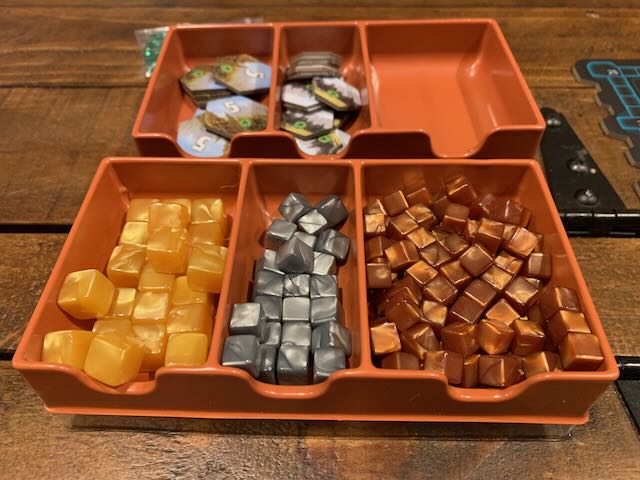
In my collection, Dune Imperium is the gold standard for solo play. This game is just below that. The timing mechanism with the phase cards is pretty clever and I found that most games ran about an hour once I got into the swing of things. It was 1 hour of pure tableau engine-building goodness. I loved puzzling over the choices in my hand and the anticipation of hoping I did not play the same phase as the AI. I miss seeing cards and strategies that other people play, but that is a universal drawback in all solo games I have played. Components in the collector’s edition are very high quality. The cubes have a pearlescent treatment (I think I might like them more than the real metal cubes) and the storage trays keep everything in place.
I think if there is a downside, like I mentioned before, it is the game board. It would have been nice to have been recessed, and I did bump it a couple times and had to remember the placement of everything. Feels like a missed opportunity. This is a minor gripe at best.

Overall, Terraforming Mars Ares Expedition is a great game and a worthy addition to any solo gamer’s collection. If your are a fan of the original or are just starting to dip your toes into the TM pool, you should definitely check this one out.





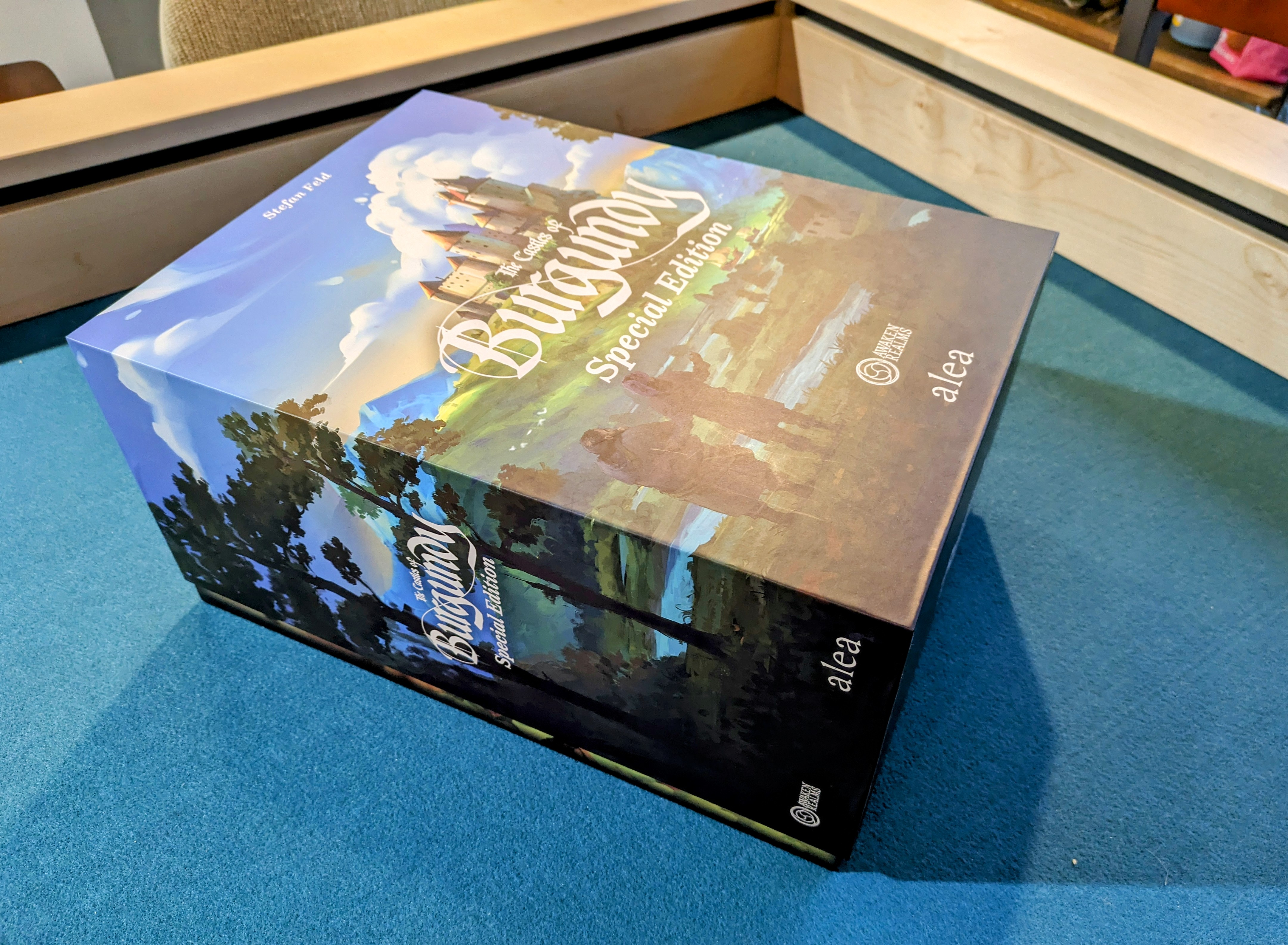
Leave a Comment